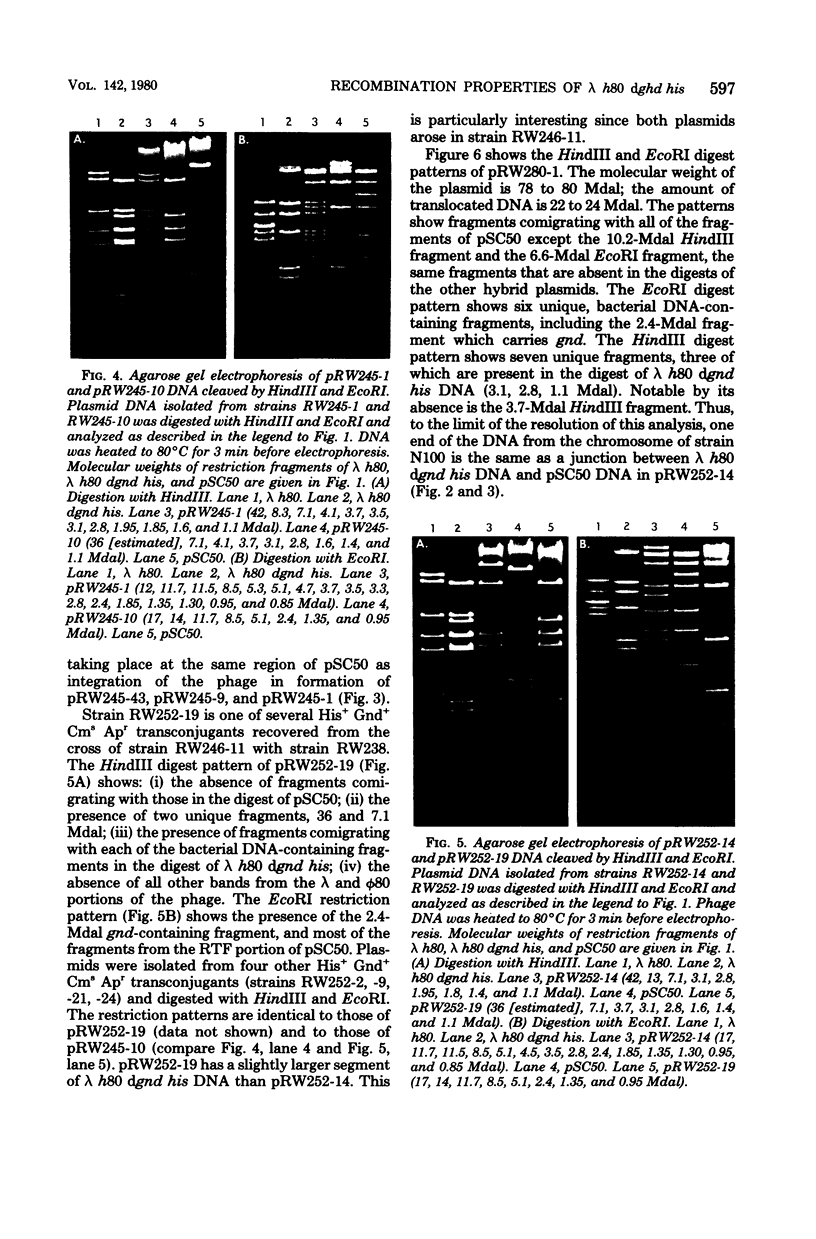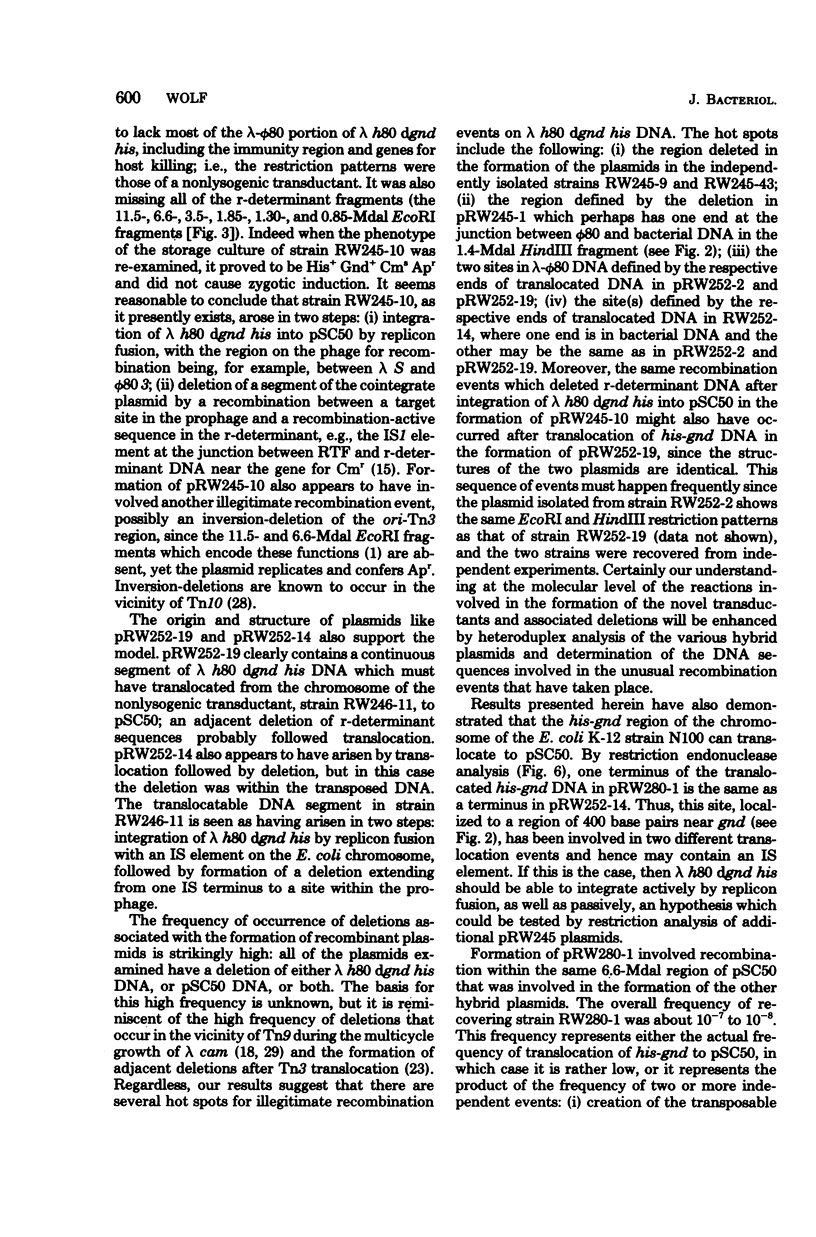Abstract
Molecular and genetic studies have revealed that several illegitimate recombinational events are associated with integration of the specialized transducing bacteriophage lambda cI57 St68 h80 dgnd his into either the Escherichia coli chromosome or into a plasmid. Most Gnd+ His+ transductants did not carry the prophage at att phi-80, and 10% were not immune to lambda, i.e., "nonlysogenic." Integration of the phage was independent of the phage Int and Red gene products and of the host's general recombination (Rec) system. In further studies, bacterial strains were selected which carried the phage integrated into an R-factor, pSC50. Restriction endonuclease analysis of plasmid deoxyribonucleic acid (DNA) purified from these strains showed that formation of the hybrid plasmids resulted from recombination between a single region of pSC50 and one of several sites within the lambda-phi 80 portion of the phage. Furthermore the his-gnd region of the phage, present in the chromosome of one nonlysogenic transductant, was shown to be able to translocate to pSC50. Concomitant deletion of phage DNA sequences or pSC50 DNA was frequently observed in conjunction with these integration or translocation events. In supplemental studies, a 22- to 24-megadalton segment of the his-gnd region of the chromosome of a prototrophic recA E. coli strain was shown to translocate to pSC50. One terminus of this translocatable segment was near gnd and was the same as a terminus of the his-gnd segment of the phage which translocated from the chromosome of the nonlysogenic transductant. These data suggest that integration of lambda cI857 St 68 h80 dgnd his may be directed by a recombinationally active sequence on another replicon and that the resulting cointegrate structure is subject to the formation of deletions which extend from the recombinationally active sequence. Translocation of the his-gnd portion of the phage probably requires prior replicon fusion, whereas the his-gnd region of the normal E. coli chromosome may comprise a discrete, transposable element.
Full text
PDF














Images in this article
Selected References
These references are in PubMed. This may not be the complete list of references from this article.
- Bachmann B. J., Low K. B., Taylor A. L. Recalibrated linkage map of Escherichia coli K-12. Bacteriol Rev. 1976 Mar;40(1):116–167. doi: 10.1128/br.40.1.116-167.1976. [DOI] [PMC free article] [PubMed] [Google Scholar]
- Blohm D., Goebel W. Restriction map of the antibiotic resistance plasmid R1drd-19 and its derivatives pKN102 (R1drd-19B2) and R1drd-16 for the enzymes BamHI, HindIII, EcoRI and SalI. Mol Gen Genet. 1978 Nov 29;167(2):119–127. doi: 10.1007/BF00266905. [DOI] [PubMed] [Google Scholar]
- Clewell D. B., Helinski D. R. Supercoiled circular DNA-protein complex in Escherichia coli: purification and induced conversion to an opern circular DNA form. Proc Natl Acad Sci U S A. 1969 Apr;62(4):1159–1166. doi: 10.1073/pnas.62.4.1159. [DOI] [PMC free article] [PubMed] [Google Scholar]
- Cohen S. N., Casadaban M. J., Chou J., Tu C. P. Studies of the specificity and control of transposition of the Tn3 element. Cold Spring Harb Symp Quant Biol. 1979;43(Pt 2):1247–1255. doi: 10.1101/sqb.1979.043.01.141. [DOI] [PubMed] [Google Scholar]
- Faelen M., Toussaint A., De Lafonteyne J. Model for the enchancement of lambde-gal integration into partially induced Mu-1 lysogens. J Bacteriol. 1975 Mar;121(3):873–882. doi: 10.1128/jb.121.3.873-882.1975. [DOI] [PMC free article] [PubMed] [Google Scholar]
- Fraenkel D. G., Banerjee S. Deletion mapping of zwf, the gene for a constitutive enzyme, glucose 6-phosphate dehydrogenase in Escherichia coli. Genetics. 1972 Aug;71(4):481–489. doi: 10.1093/genetics/71.4.481. [DOI] [PMC free article] [PubMed] [Google Scholar]
- Gill R., Heffron F., Dougan G., Falkow S. Analysis of sequences transposed by complementation of two classes of transposition-deficient mutants of Tn3. J Bacteriol. 1978 Nov;136(2):742–756. doi: 10.1128/jb.136.2.742-756.1978. [DOI] [PMC free article] [PubMed] [Google Scholar]
- Gottesman M. E., Yarmolinsky M. B. The integration and excision of the bacteriophage lambda genome. Cold Spring Harb Symp Quant Biol. 1968;33:735–747. doi: 10.1101/sqb.1968.033.01.084. [DOI] [PubMed] [Google Scholar]
- Helling R. B., Goodman H. M., Boyer H. W. Analysis of endonuclease R-EcoRI fragments of DNA from lambdoid bacteriophages and other viruses by agarose-gel electrophoresis. J Virol. 1974 Nov;14(5):1235–1244. doi: 10.1128/jvi.14.5.1235-1244.1974. [DOI] [PMC free article] [PubMed] [Google Scholar]
- Hopkins J. D. A new class of promoter mutations in the lactose operon of Escherichia coli. J Mol Biol. 1974 Aug 25;87(4):715–724. doi: 10.1016/0022-2836(74)90080-1. [DOI] [PubMed] [Google Scholar]
- Isturiz T., Wolf R. E., Jr In vitro synthesis of a constitutive enzyme of Escherichia coli, 6-phosphogluconate dehydrogenase. Proc Natl Acad Sci U S A. 1975 Nov;72(11):4381–4384. doi: 10.1073/pnas.72.11.4381. [DOI] [PMC free article] [PubMed] [Google Scholar]
- Kaiser K., Murray N. E. Physical characterisation of the "Rac prophage" in E. coli K12. Mol Gen Genet. 1979 Sep;175(2):159–174. doi: 10.1007/BF00425532. [DOI] [PubMed] [Google Scholar]
- Kopecko D. J., Brevet J., Cohen S. N. Involvement of multiple translocating DNA segments and recombinational hotspots in the structural evolution of bacterial plasmids. J Mol Biol. 1976 Dec;108(2):333–360. doi: 10.1016/s0022-2836(76)80124-6. [DOI] [PubMed] [Google Scholar]
- Kopecko D. J., Cohen S. N. Site specific recA--independent recombination between bacterial plasmids: involvement of palindromes at the recombinational loci. Proc Natl Acad Sci U S A. 1975 Apr;72(4):1373–1377. doi: 10.1073/pnas.72.4.1373. [DOI] [PMC free article] [PubMed] [Google Scholar]
- Kupersztoch Y. M., Helinski D. R. A catenated DNA molecule as an intermediate in the replication of the resistance transfer factor R6K in Escherichia coli. Biochem Biophys Res Commun. 1973 Oct 15;54(4):1451–1459. doi: 10.1016/0006-291x(73)91149-2. [DOI] [PubMed] [Google Scholar]
- MacHattie L. A., Shapiro J. A. Chromosomal integration of phage lambda by means of a DNA insertion element. Proc Natl Acad Sci U S A. 1978 Mar;75(3):1490–1494. doi: 10.1073/pnas.75.3.1490. [DOI] [PMC free article] [PubMed] [Google Scholar]
- Meyer R., Boch G., Shapiro J. Transposition of DNA inserted into deletions of the Tn5 kanamycin resistance element. Mol Gen Genet. 1979 Mar 9;171(1):7–13. doi: 10.1007/BF00274009. [DOI] [PubMed] [Google Scholar]
- Ohtsubo H., Ohmori H., Ohtsubo E. Nucleotide-sequence analysis of Tn3 (ap): implications for insertion and deletion. Cold Spring Harb Symp Quant Biol. 1979;43(Pt 2):1269–1277. doi: 10.1101/sqb.1979.043.01.144. [DOI] [PubMed] [Google Scholar]
- Reif H. J., Saedler H. IS1 is involved in deletion formation in the gal region of E. coli K12. Mol Gen Genet. 1975;137(1):17–28. doi: 10.1007/BF00332538. [DOI] [PubMed] [Google Scholar]
- Ross D. G., Swan J., Kleckner N. Physical structures of Tn10-promoted deletions and inversions: role of 1400 bp inverted repetitions. Cell. 1979 Apr;16(4):721–731. doi: 10.1016/0092-8674(79)90088-6. [DOI] [PubMed] [Google Scholar]
- Shapiro J. A. Molecular model for the transposition and replication of bacteriophage Mu and other transposable elements. Proc Natl Acad Sci U S A. 1979 Apr;76(4):1933–1937. doi: 10.1073/pnas.76.4.1933. [DOI] [PMC free article] [PubMed] [Google Scholar]
- Shimada K., Takagi Y. Integration of the lambda genome in the absence of site-specific integration function: isolation of an abnormally permuted prophage lambda. Biochem Biophys Res Commun. 1976 Jul 12;71(1):68–75. doi: 10.1016/0006-291x(76)90250-3. [DOI] [PubMed] [Google Scholar]
- Shimada K., Weisberg R. A., Gottesman M. E. Prophage lambda at unusual chromosomal locations. I. Location of the secondary attachment sites and the properties of the lysogens. J Mol Biol. 1972 Feb 14;63(3):483–503. doi: 10.1016/0022-2836(72)90443-3. [DOI] [PubMed] [Google Scholar]
- Sunshine M. G. Dependence of education on P2 int product. Virology. 1972 Jan;47(1):61–67. doi: 10.1016/0042-6822(72)90239-5. [DOI] [PubMed] [Google Scholar]
- Sunshine M. G., Kelly B. Extent of host deletions associated with bacteriophage P2-mediated eduction. J Bacteriol. 1971 Nov;108(2):695–704. doi: 10.1128/jb.108.2.695-704.1971. [DOI] [PMC free article] [PubMed] [Google Scholar]
- Toussaint A., Faelen M. Connecting two unrelated DNA sequences with a Mu dimer. Nat New Biol. 1973 Mar 7;242(114):1–4. doi: 10.1038/newbio242001a0. [DOI] [PubMed] [Google Scholar]
- Wolf R. E., Jr, Fraenkel D. G. Isolation of specialized transducing bacteriophages for gluconate 6-phosphate dehydrogenase (gnd) of Escherichia coli. J Bacteriol. 1974 Feb;117(2):468–476. doi: 10.1128/jb.117.2.468-476.1974. [DOI] [PMC free article] [PubMed] [Google Scholar]
- Wolf R. E., Jr, Shea F. M. Combined use of strain construction and affinity chromatography in the rapid, high-yield purification of 6-phosphogluconate dehydrogenase from Escherichia coli. J Bacteriol. 1979 Apr;138(1):171–175. doi: 10.1128/jb.138.1.171-175.1979. [DOI] [PMC free article] [PubMed] [Google Scholar]






